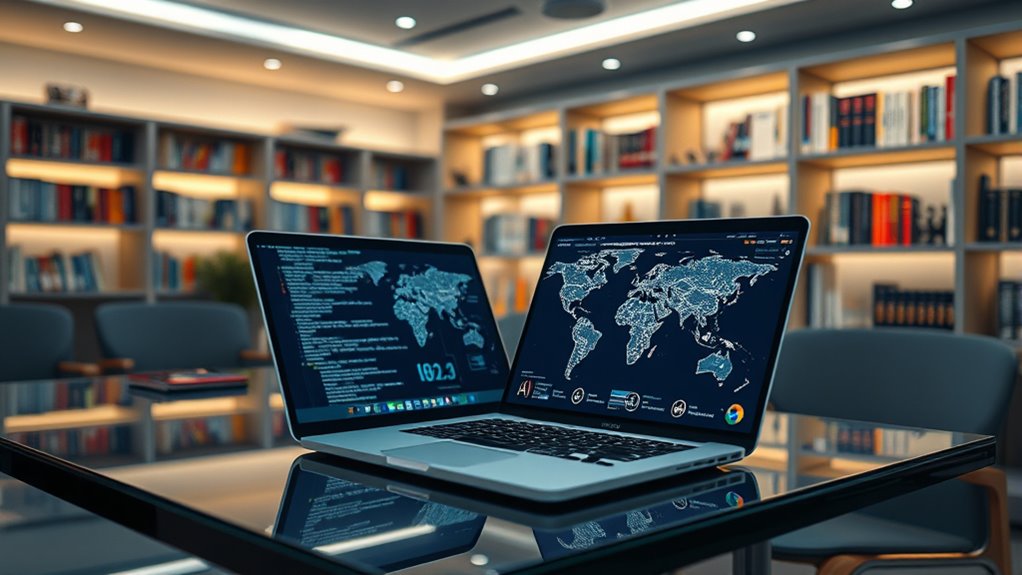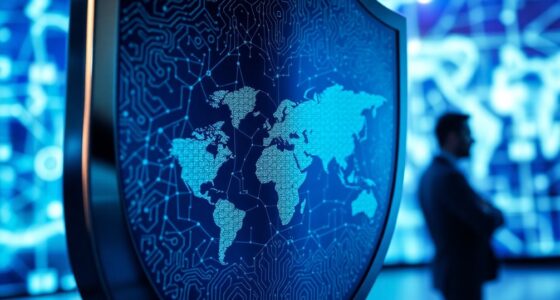Export controls on AI models distinguish between civilian uses and potential weapons, mainly to prevent misuse in military or malicious activities. If an AI system is used for autonomous weapons, targeting, espionage, or sabotage, it may be classified as a weapon and face strict restrictions. These regulations aim to protect security without hindering beneficial innovations. To understand what specific criteria determine weapon status and how authorities evaluate AI, keep exploring these important guidelines.
Key Takeaways
- AI models used for offensive military purposes, such as autonomous weapons or targeting systems, are considered potential weapons under export controls.
- AI systems capable of espionage, sabotage, or influence operations that could threaten security are classified as weapons.
- Regulations focus on AI’s capability to be weaponized or adapted for malicious use, regardless of civilian or military origin.
- Definitions of AI as weapons include models enhancing autonomous decision-making in military applications.
- Licensing and classification depend on AI’s technical features and intended end-use to determine if it qualifies as a controlled weapon.

As artificial intelligence models become more advanced and widely adopted, governments around the world are implementing export controls to regulate their transfer across borders. These controls aim to prevent potentially dangerous AI technology from falling into the wrong hands, whether for malicious purposes or unauthorized military use. But what exactly counts as a weapon when it comes to AI models? That’s where the debate gets complex. It’s not always clear-cut, and the line between civilian applications and military or malicious uses can blur quickly. Governments are trying to define these boundaries, but the definitions often lag behind rapid technological developments.
You need to understand that export controls aren’t just about stopping the sale of high-tech gadgets. They extend to sophisticated AI models capable of performing tasks that could threaten national security or international stability. For instance, an AI system designed for cybersecurity might be classified as a controlled item if it can be used to breach secure systems or disrupt critical infrastructure. Similarly, AI models that can generate realistic deepfakes or manipulate information could be restricted because of their potential for misuse. The key factor is whether the AI can be weaponized or used in ways that undermine security or violate international norms.
Governments are increasingly considering AI models as potential weapons if they can be used for offensive military applications, such as autonomous weapons systems or strategic decision-making tools. If an AI model can be used to improve targeting accuracy in weapons or to develop autonomous drones, it’s more likely to fall under export restrictions. But it’s not just military uses; AI that can be employed for espionage, sabotage, or influence operations also raises concerns. The challenge lies in balancing the need to prevent misuse with the desire to foster innovation and economic growth. Overly broad restrictions could stifle beneficial research, while too lax policies might enable malicious actors.
AI models as potential weapons for military and malicious uses pose regulatory challenges and balance innovation risks
You also need to be aware that many regulations hinge on the technical capabilities of the AI models and their intended end-use. Export controls often consider whether the AI can be adapted for military or intelligence purposes, and whether it includes specific features that could make it a weapon. The process involves detailed classification and licensing procedures, which can be complex. As AI continues to evolve, so will the definitions of what constitutes a weapon, making it essential for researchers, companies, and governments to stay informed and compliant. Moreover, understanding the Indian numbering system can help contextualize the scale of data and resources involved in AI development and regulation. Ultimately, the goal is to prevent AI from being used as a tool of harm, while still allowing innovation to flourish in safe, controlled ways.
Frequently Asked Questions
How Do Export Controls Affect International Collaborations on AI Development?
Export controls can considerably hinder your international collaborations on AI development. They impose restrictions on sharing certain technologies, data, or models across borders, which may delay projects or limit access to essential resources. You might find yourself needing to navigate complex regulations, obtain licenses, or face compliance challenges. These measures aim to prevent sensitive AI from falling into wrong hands, but they can also create hurdles for your global research and partnership efforts.
What Are the Penalties for Violating AI Export Restrictions?
If you violate AI export restrictions, you could face severe penalties, including hefty fines and criminal charges. The government can also seize assets or deny you future export privileges. You might get jail time if the violation is serious. It’s important to understand and follow these rules carefully to avoid legal trouble. Always check the specific regulations and consult legal experts before sharing sensitive AI technology internationally.
Are Open-Source AI Models Subject to Export Controls?
Open-source AI models are like open books—generally, they’re not subject to export controls, but it depends. If your open-source model includes advanced features or sensitive technology, authorities might classify it as controlled. You need to carefully review export regulations and licensing terms. Ignoring these rules can lead to serious penalties. Stay informed, and when in doubt, consult legal experts to guarantee you’re compliant with export laws.
How Can Companies Ensure Compliance With Evolving AI Export Laws?
You can guarantee compliance by staying informed about current export laws through regular legal updates and consulting with export control experts. Implement strict internal policies, conduct thorough risk assessments, and classify your AI models accurately. Train your team on export regulations, maintain detailed documentation, and establish compliance audits. Using these proactive measures helps you adapt quickly to legal changes, reducing the risk of violations and safeguarding your company’s international operations.
What Role Do International Treaties Play in AI Export Regulations?
International treaties act like a global safety net, weaving countries together in shared rules for AI exports. They set the boundaries, much like fences around a garden, ensuring AI technology doesn’t fall into the wrong hands. As you navigate export laws, these treaties guide your actions, helping you avoid crossing into risky territory. They create a common language, fostering cooperation and trust among nations in managing AI’s potential dangers.
Conclusion
In the end, understanding what qualifies as a weapon when it comes to AI models isn’t black and white. You need to stay alert and keep up with evolving regulations, because the lines are often blurred. Remember, when it comes to export controls, you’re always better safe than sorry. It’s a fine line you walk, but by staying informed, you can navigate the maze and avoid putting your organization in hot water.









